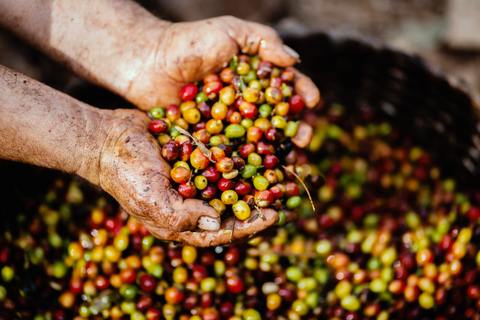Coffee Cultivation in California

In recent years, California has been witness to an explosion in the diversity of locally produced goods available. Many of the crops that nowadays are considered part of the identity and economic engine of California- like in the case of California oranges and grape plantations, and more recently locally grown avocado. These crops eventually grew prosperous from the work of both farmers and researchers that worked hard to develop varieties suitable to the weather and land conditions.
In the case of coffee, the major producing countries are located far away from California- in Africa (for example, Ethiopia and Kenya), South and Central America (for example, Costa Rica and Colombia), and in other locations inside the so called “coffee belt” (for example, Indonesia) where the climatic conditions meet to allow both Robusta and Arabica varieties to grow and fulfill their temperature, humidity and sunlight requirements. This “belt” isn’t necessarily a fixed zone- climate change and geopolitical forces affect agricultural schemes worldwide. While these changes risk the source of income for thousands of poor coffee producers, windows for opportunities could open in areas not commonly associated with coffee cultivation.
R: Robusta, M: Mixed, A: Arabica
In the United States, Hawaii has historically been the United States chief coffee producer- having the first recorded document of coffee plants in the O’ahu island dated in 1813. However, California is slowly entering into the coffee market in the last two decades. The uptick in coffee production has particularly helped to offset decreasing production of avocados in recent years due to drought and incidence of bacterial diseases attacking citrus plantations (for example, the yellow dragon disease- “Citrus Greening”- “HLB”).
The Introduction of Coffee Cultivation to California
Mark Gaskell, a farm advisor from the University of California responsible for the introduction of a variety of different crops (for example, blueberries) to farmers in California, was instrumental in bringing coffee production to California. In his quest to introduce coffee to California’s rapidly expanding list of crops, he found an important partner in Jay Ruskey. Ruskey, after studying agribusiness at California Polytechnic State University in San Luis Obispo, founded Good Land Organics Farm in 1992 in Santa Barbara. Ruskey and Gaskell experimented to find varieties that could thrive in conditions atypical for coffee and eventually managed to succeed in cultivating coffee in the California climate. Coffee cultivation has continued to expand in California ever since.
The Coffee Varieties of Californian Coffee
In addition to the factors of the particular variety of bean, the processing method, and the roasting technique, origin has a tremendous impact on the flavor notes of coffee. While Californian origin is not yet as recognizable as an origin as Colombian, Ethiopian, or Brazilian, it is continuing to improve in both quality and reputation.
In new Californian coffee farms, the varieties Cuicateco (a Sarchimor variety selected in Oaxaca), as well as Caturra (pictured below) and Bourbon (both traditional varieties used in Central America, Colombia and Venezuela) are extremely popular. These varieties have proven particularly compatible with the west coast climate. Each variety of bean carries advantages and disadvantages with respect to California’s agronomic conditions (tolerance to climate: drought, frost; diseases; productivity) as well a different taste/flavor profile. Additionally, many Californian coffee farmers are increasingly becoming interested in Geisha and others “trending” varieties that could potentially bring higher revenues.

As opposed to the drying patios to produce natural dried coffee utilized in other coffee regions, most new Californian coffee farmers have learned to use the “wet” process to remove the pulp and produce only washed coffee beans- leaving the roasters to continue experimenting with different blends of the available varieties and roasting methods to develop their own distinct flavors for their brands and gradually improve the perception of the Californian coffee “origin”.
Potential Growing Techniques: Lessons from the Tropics
In tropical areas, farmers can choose to produce coffee in shade (under the canopy of other trees like pictured below) or in open coffee plantations with total exposure to sunlight. In the case of the latter, plantations statistically can yield higher productions with a growing rate higher than that of coffee grown in shade. However, the evapotranspiration- the process by which plants lose water to the atmosphere- rate from coffee leaves increases too, demanding more water and application of fertilizers to sustain the growing of the plants. At the same time, coffee grown under the canopy in fresh climates in tropical regions shown to promote a better filling and ripening of the coffee cherries and formation of coffee beans, improving the aroma profile of the yield, requiring less water and fertilizer inputs.
Considering this dynamic and the current problems with drought and water supply in California, integrated, or shade grown, coffee cultivation systems would seem to be of great interest to those seeking to grow in California. The nearby Mexican growing regions of Oaxaca and Veracruz have environmental conditions not so different from southern California. Adapting shady cultivation systems to old avocado plantations would allow growers to take advantage of their canopy to facilitate the growth of young coffee plants and allowing the application of organic cultivation methods. The introduction of organically grown coffee could additionally represent a welcome relief for the bees that are being decimated by the intensive use of insecticides in orange plantations.
The Future of California Coffee
Coffee has quickly become a welcome revenue source for California farmers and becoming increasingly well known in the US market. Californian farmers are constantly improving their techniques- experimenting with new varieties, blends, and roasting techniques to craft their own unique flavors. Within the coming decade, expect Californian coffee to continue to expand throughout the US and become ubiquitous across supermarkets and specialty coffee stores.
